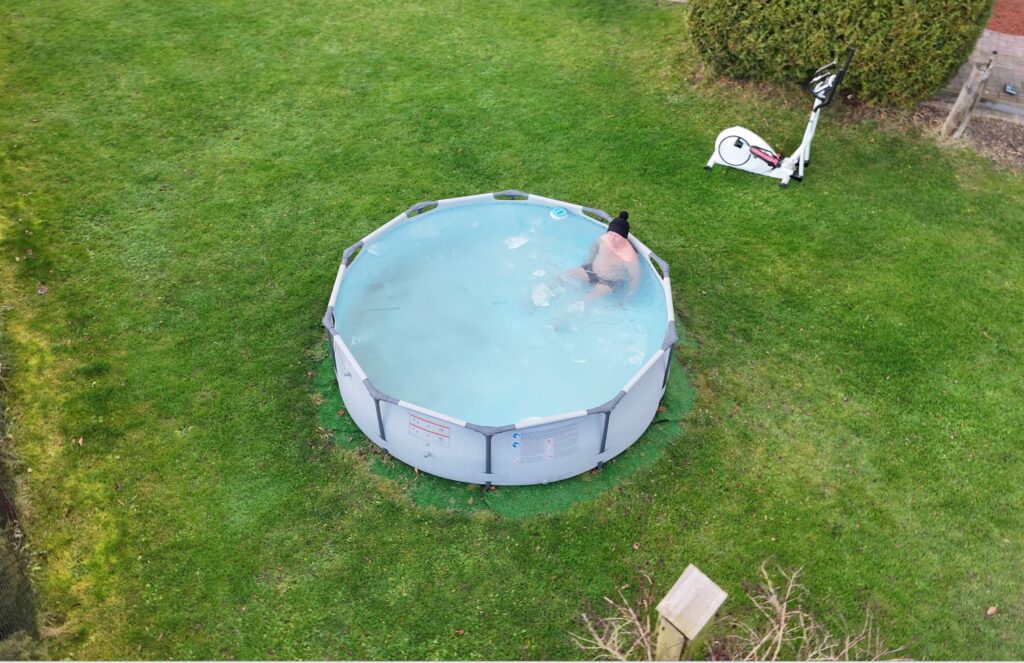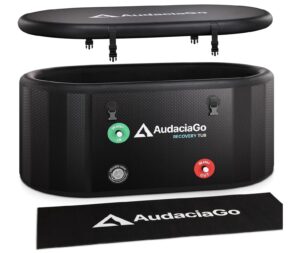We will enjoy the Wim Hof technique benefits only in the long term, so be patient my friends.
Welcome to the world of the Wim Hof Method, where ice and breath come together to create a unique wellness experience. This technique, crafted by the Dutch daredevil Wim Hof, also known as the “Iceman,” is about pushing human limits and harnessing the power of nature.
You might wonder how Wim Hof earned the nickname “Iceman.” Well, he’s broken quite a few world records by doing things like running half-marathons barefoot on ice and swimming under frozen lakes. But beyond the cool feats, his method is rooted deeply in three main pillars: breathing techniques, cold exposure, and a solid dose of commitment.
The breathing part isn’t just about taking deep breaths. It’s a specific technique designed to bring about physiological changes in your body. Think of increased energy, reduced stress, and an overall feeling of zen. It’s like a workout for your lungs that impacts your entire body.
Cold exposure is another pivotal piece of the puzzle. Hof suggests gradually introducing your body to cold environments to boost circulation and resilience. Whether it’s a cold shower, ice bath or a brisk winter walk, the idea is to step out of your comfort zone.
Lastly, don’t sleep on the power of commitment. This isn’t just another wellness fad—commitment is crucial to experiencing the real benefits. It’s about embracing the challenge and sticking with it even when the cold feels unbearable.
The Scientific Backing: Benefits of the Wim Hof Technique
Let’s understand why the Wim Hof Method is more than just a viral sensation. There’s a bunch of scientific research backing the benefits of this method, making it a legitimate tool for boosting your health.
First off, let’s talk immunity. Several studies show that the Wim Hof Method can help regulate your immune response. Imagine being able to fend off colds with a little bit of breathing and cold showers—sounds amazing, right? It’s all about training your body to become more resilient to stress.
Focusing isn’t a walk in the park for everyone, but Wim Hof’s breathing techniques can heighten your concentration and mental clarity. Think of it like clearing out the mental cobwebs to let your brain shine. The physiological shift in your body when practicing these techniques is like hitting the refresh button on your system.
There’s also an increase in energy levels. The deep breathing techniques oxygenate your body fully, which boosts your energy and uplifts your mood. Amping up your energy in such a natural way can be a total game-changer for those afternoon slumps.
Numerous studies have looked at what’s happening inside the body while practicing WHM, from changes in metabolic rate to adrenaline levels. Understanding these shifts helps you see just how potent this method can be. It’s no substitute for professional medical advice, of course, but it’s certainly an intriguing addition to one’s wellness arsenal.
Demystifying the Wim Hof Breathing Technique
The Wim Hof breathing technique is at the heart of this method, serving as a doorway to better mental and physical health. But it’s not just any breathwork—it’s designed to tap into deep layers of the body and mind, bringing about profound changes.
The practice begins with controlled hyperventilation, which involves taking 30 to 40 deep breaths quickly: breathing in fully and letting out easily. You’re essentially flooding your body with oxygen, increasing your blood alkalinity. This altered state can lead to heightened awareness and a sense of tranquility.
After this round, you hold your breath for as long as it’s comfortable, then do a recovery breath and hold it for about 15 seconds. This cycle can be repeated multiple times, and it’s all about listening to your body and gently pushing your own limits.
Sounds powerful, right? Now, the benefits of this deliberate breathing style include reducing stress, enhancing concentration, and improving sleep quality. It encourages the production of endorphins, giving you that natural high and helping to align your mental state.
But breathe safely! As with any method that affects your physiology, there are potential risks. It’s crucial to practice in a safe environment and avoid water activities during breath retention, and those with medical conditions should definitely consult a professional first.
This breathing technique isn’t just about ticking a box—it’s a path to exploring a more mindful connection with how you breathe and how it affects your everyday well-being.
Overcoming the Challenges: Mastering the Wim Hof Method
Jumping into the Wim Hof Method sounds exhilarating, doesn’t it? But like any skill worth mastering, it’s not without its hurdles. Let’s tackle some common challenges folks run into when embracing this icy path to well-being.
The first challenge many experience is the commitment to regular practice. Finding the motivation to keep at it, especially when life throws its usual curveballs, can be tricky. Consistency is key with WHM, so setting a routine helps make the practice a part of your day, like brushing your teeth or brewing your morning coffee.
Next up, cold exposure. For many, the idea of purposely subjecting oneself to cold is daunting. But the good news is that you don’t need to plunge into icy waters right away. Start small with cold showers and gradually decrease the temperature as you become more comfortable.
Then there’s the mental aspect. Staying calm and focused while your body adjusts to the breathing and cold exposure can be challenging. It’s about finding your inner rhythm and cultivating patience with yourself. Progress might be slow at first, but that’s totally normal. Celebrate the small victories and keep pushing forward.
Transforming challenges into triumphs, a lot of success stories come from everyday people who stick with it. They find strength they didn’t know they had and a clearer, more energized mindset. The key is to remain open to the process and remember that each person’s journey with the Wim Hof Method is uniquely their own.
Exploring Alternatives: Other Methods to Boost Health and Vitality
The Wim Hof Method isn’t the only game in town when it comes to boosting your wellness. If you’re curious about other paths to health, there are a bunch of alternatives and complementary practices to consider.
Yoga, for instance, offers a holistic approach to building strength and flexibility while promoting mental clarity. The focus on breathwork in yoga can mesh well with WHM, offering a balanced approach to wellness.
Then there’s meditation, a practice that’s all about calming the mind and finding peace in stillness. If the intensity of WHM breathing feels overwhelming, meditation can be a gentler option, helping to foster mindfulness and reduce stress naturally.
High-intensity interval training (HIIT) is another method on the physical side of things. While it doesn’t involve breath work or cold exposure, its dynamic nature complements the vitality you seek with WHM, providing a different type of high through physical exertion.
For those heading in a different direction, exploring tai chi or qigong offers low-impact alternatives focused on the energy flow within the body, perfectly suited for all ages and levels of fitness.
Each of these alternatives carries its own unique benefits and can be tailored to fit personal preferences and lifestyles. Whether you’re sticking with the Wim Hof Method or mixing it up with other practices, the important thing is that it fits your life and goals, keeping you energized and engaged in the journey to better health.
As an Amazon Associate I earn from qualifying purchases.








This was a very interesting read on Wim Hof and it is the first time that I have heard about this topic. I have read that it is good for you to take ice baths, but this also incorporates the breathing techniques.
I can’t get myself to step into a cold swimming pool so can you give some helpful advice on how to get your body slowly used to the idea of taking these ice baths?
Thank you for your thoughtful comment! It’s great to hear that you found the read on Wim Hof interesting. Starting with ice baths can definitely feel intimidating, especially if you’re not a fan of cold water. Here are a few tips to help you ease into the practice:
Start Small: Begin with cooler, not cold, showers. Gradually reduce the temperature over time as your body adapts.
Practice Controlled Breathing: Use deep, diaphragmatic breathing techniques to calm your body. Wim Hof’s breathing method can help you stay relaxed and focused, even in colder conditions.
Short Duration: Start with just 10–15 seconds of cold exposure at the end of your shower and gradually increase the time as you become more comfortable.
Prepare Mentally: Visualize the experience positively. Focus on the benefits, such as improved energy and mental clarity, rather than the discomfort.
Warm Up First: Engage in light exercise before cold exposure to make the transition less shocking to your body.
Experiment with Cold Water Immersion: Begin by immersing just your feet or hands in cold water to help your body adapt incrementally.
Stay Consistent: Regular practice, even for short durations, helps train your body and mind to tolerate the cold more effectively over time.
It’s also helpful to approach it as a gradual journey rather than diving in all at once. With consistency and patience, you might find yourself embracing the practice more easily. Let me know how it goes for you!
Enhanced Immune Function
The Wim Hof Method has been shown to boost the immune system. Practitioners often experience fewer illnesses and infections. This is due to the method’s ability to increase the production of white blood cells, which are crucial for fighting off pathogens. A study published in the Proceedings of the National Academy of Sciences demonstrated that participants who practiced the Wim Hof Method had a stronger immune response to endotoxins compared to those who did not.
The Wim Hof Method has indeed shown promising results in boosting the immune system, as demonstrated in studies like the one published in the Proceedings of the National Academy of Sciences. The combination of controlled breathing, cold exposure, and meditation appears to influence the autonomic nervous system and the immune response. However, while the evidence is compelling, it’s worth noting that more research is needed to understand the long-term effects and mechanisms fully. It’s always a good idea to consult with a healthcare professional before starting any new health regimen, especially one that involves cold exposure or intensive breathing exercises.
The Wim Hof Method is indeed a fascinating approach to wellness that combines the power of breathwork and cold exposure.
It’s great to see the emphasis on commitment and consistency, as these are often the keys to unlocking the benefits of any health regimen.
I’m curious about how one might measure progress with the Wim Hof Method. Are there specific milestones or markers that practitioners look for to gauge their advancement?
Absolutely, the Wim Hof Method emphasizes the importance of commitment and consistency! Progress can often be measured in a few ways, depending on personal goals. For example, in breathwork, practitioners might notice they can hold their breath for longer durations over time, indicating improved lung capacity and oxygen efficiency. With cold exposure, milestones could include being able to stay in cold water for longer periods while maintaining calmness and control. Additionally, many report subjective markers like increased energy, reduced stress, and better recovery. Keeping a journal of these experiences can be a great way to track advancement! One minute in an ice bath reduces stress by 90 %. I have been doing this for about four months and feel perfect. I am 66.
This is the first time I heard Wim Hot Method that help boasting immune system. But I think it fits only to younger generation who are healthy and strong, for those who are in older age like me sixty up years, maybe it is not match. But I believe that the Wim Hot Method is amazing new method that evolves cold exposure or breathing exercise.
The Wim Hof Method can actually be beneficial for people of all ages, including those 60 and older! While the intensity might need to be adjusted, especially for beginners or those with health concerns, many older individuals find the breathing exercises and gradual cold exposure to be quite invigorating. Of course, it’s always a good idea to consult a healthcare professional before starting, but with proper guidance, the method can help improve overall well-being, including boosting the immune system.
I have heard of the Wim Hof method before and thought it a little extreme in my opinion. The benefits sure seem to be great though. The cold exposure is the part that I might have second thoughts about, but having increased immunity, mental clarity, and an energy boost all would be fine and dandy with me. Do you need to do the Wim Hof Method everyday?
The Wim Hof Method definitely seems intense at first, especially the cold exposure part! But it’s great that you’re interested in the benefits—it really does help with things like immunity, mental clarity, and energy. You don’t *have* to do it every day, but consistency is key to seeing the best results. Some people start slow, maybe with just the breathing exercises or a quick cold shower, and then build up over time. It’s all about finding what works for you! I am doing breathing and ice bath almost every day right after waking up, and it takes me about one hour.
This is such an intriguing dive into the Wim Hof Method! I’ve always been curious about how breathing and cold exposure can influence both mental and physical well-being. One question I have is about the commitment aspect—how do people stay consistent with cold showers or breathwork, especially during busy schedules or colder months?
Personally, I’ve tried cold showers a few times, and while they were refreshing, sticking to them daily felt challenging. Does anyone have tips or experiences that helped them embrace this method long-term? I’d love to hear if you’ve found significant benefits, especially in energy or stress reduction. It sounds like an exciting way to push boundaries and explore personal resilience!
Thank you for sharing your curiosity and experiences! The Wim Hof Method truly is a fascinating journey into the connection between mind and body. Consistency can be a challenge, especially with cold showers and breathwork, but a few strategies might help:
Start Small: Instead of diving straight into a full cold shower, ease into it by ending your regular shower with 15-30 seconds of cold water. Gradually increase the duration as your body adapts.
Pair It With a Habit: Tie your breathwork or cold showers to an existing daily habit, like brushing your teeth or after your morning coffee. This can help you build a consistent routine.
Focus on the Benefits: Keeping the benefits in mind—like improved energy, reduced stress, and enhanced resilience—can be motivating. Journaling any positive changes you notice might also encourage you to stick with it.
Community Support: Joining a group or online community practicing the Wim Hof Method can provide accountability and inspiration. Sharing experiences and tips can make it feel more sustainable.
Adapt to Your Schedule: Even if you’re busy, remember that the breathwork can take as little as 10 minutes, and a cold shower doesn’t need to be lengthy to be effective.
I’ve personally found that the mental clarity and energy boost are worth the initial discomfort. It’s like a daily mental workout that strengthens resilience. Have you noticed any specific benefits in the times you’ve tried it? Would love to hear more about your experience!
This is an excellent and well-researched overview of the Wim Hof Technique! I appreciate how you’ve broken down the benefits in a clear and compelling way, making it easy for both beginners and experienced practitioners to understand the potential impact. The combination of breathwork, cold exposure, and mindset training is truly fascinating, and you do a great job of explaining how it can improve mental and physical well-being. Your insights into the scientific backing behind the technique add even more credibility, making this a valuable resource for anyone interested in biohacking and holistic health.
For someone new to the Wim Hof Method, what would you recommend as the best way to ease into the practice, especially when it comes to cold exposure? Should beginners start with shorter cold showers, or is there a specific approach that helps build tolerance more effectively?
I’ve personally experimented with the Wim Hof breathing technique and found it incredibly effective for boosting energy and reducing stress. Incorporating cold showers was a challenge at first, but over time, I noticed improved resilience and circulation. One thing that helped me was focusing on controlled breathing during the cold exposure, which made it much easier to tolerate. Have you noticed any particular mindset techniques that help beginners push past the initial discomfort of the cold?
Thank you for your thoughtful and encouraging comment! I’m glad you found the overview helpful and engaging.
For beginners easing into cold exposure, starting with shorter cold showers is definitely a great approach. I’d recommend beginning with 15-30 seconds of cold water at the end of a warm shower and gradually increasing the duration over time. Another effective method is contrast showers—alternating between hot and cold—which helps the body adapt more smoothly.
Controlled breathing, as you mentioned, is key to making cold exposure more tolerable. A helpful mindset technique is reframing the discomfort as a challenge rather than a threat. Focusing on slow, deep breaths and viewing the cold as an opportunity to build resilience can make a huge difference. Some people also find it useful to set a small goal, like staying calm for just a few more seconds, to gradually extend their tolerance.
It’s great to hear that you’ve experienced benefits like increased energy and improved circulation! The combination of breathwork and cold exposure really does have profound effects on both the body and mind. Keep up the awesome practice! I forgot to mention that I am doing about 50-60 push-ups before a cold bath to warm up a bit, as it is freezing some days. 🚀❄️